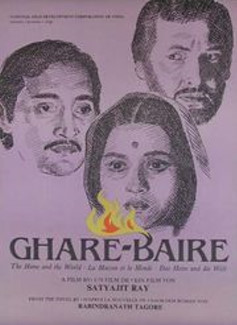
GHARE -BAIRE (THE HOME AND THE WORLD)
India, 1984, 140 minutes, Colour.
Soumitra Chatterjee, Victor Banerjee, Swatilekha Chatterjee, Jennifer Kendal.
Directed by Satyajit Ray.
Ghare-Baire? is a novel by Nobel Award-winning author Rabindranath Tagore. Writer-director Satyajit Ray had written a screenplay for the film but it was sold to another company but never produced. Thirty years on, he rewrote the screenplay and directed this film. He suffered a heart attack during the making of it and made very few films after this before his death in 1992. He is considered a world director, and certainly the great director of Indian Bengal.
His interest in the history of Bengal is very evident in his choice of the novel as well as his exploration of pre-independence Bengal. Set at the beginning of the 20th century, the film focuses on the tensions in the prospective divisions of Bengal into Hindu and Muslim Bengals.
The film focuses on a husband and wife (Soumitra Chatterjee and Victor Banerjee). He is very sympathetic to the British way of life. He is also feminist in his perspective on how his wife should lead her life. He encourages her studies, learning English, learning music (from the teacher played by Jennifer Kendal).
However, a friend from study days enters their lives. He is anti the influence of the British and leads protests against the importation of foreign-made goods. This attracts the wife, she becomes involved in his protests, also falling in love with him.
The screenplay explores the various issues of Indian identity, Bengali identity, pre-independence India, the struggles with the British, the political and economic issues as well as the cultural issues.
The film also shows the humanity of the central characters, their loves and their struggles. To that extent, the film works a fine blend between the narrative and the storytelling and the explorations of themes and issues.
1. The impact of the film? For an Indian audience? Bengali audience? The world audience – helping them to appreciate and understand this history of India? The work of Tagore, his literary work, musical, Nobel Prize? His interpretation of his India? Satyajit Ray and his reputation, his films, the artistic qualities, his insight into character and Indian history?
2. The 1907 setting, Bengal? The home and its rooms, the atmosphere of the villa? The estate? The surrounding village? The Hindus and Muslims living together, collaboration, tensions? The musical score, the songs?
3. The history of India and the British occupation? The heritage of the 18th and 19th centuries? The impact of Lord Curzon, the decision to divide Bengal, Hindus and Muslims, the philosophy of divide and rule? The particular issues of trade and the importation of foreign goods? Banning them?
4. The political issues and audience sympathies? The central characters and the screenplay’s dialectic between the three? Rights and wrongs? Causes? People using each other, the consequences?
5. Bimala and the fire, the beginning and end, her transformation throughout the film? The woman symbolising the motherland? Her grief and experiences, the personal involvement, love, disillusionments?
6. Bimala and the narrative, her relationship with her loving husband? Her sister-in-law? Her going to the lessons, the friendship with Miss Gilby? Her learning? Her reaction to western ways? Her change of clothes? Nikhil and his ideas, progressive? The beginnings of disagreement? Sandip’s arrival, her listening, watching him, her reactions? The issues of foreign goods and the protest? The effect on her mind and understanding? The changing of Indian women? The song and her being stirred? Everything new? Coping, reactions, Nikhil’s difficulties? Powers of persuasion? Sandip, the relationship, joy, illness, the seduction? The issue of money? Not knowing where all this was leading? Sandip’s stay, passion, and yet her love for Nikhil? The gold and the jewels? The truth, her grief, letting go, Nikhil’s death? Her world destroyed? The portrait of the development of a capable modern woman?
7. Nikhil as a good man, his attempts to live life with integrity, his relationship with the poor? His studies, his beliefs, English, sympathy for the British? His relationship with Bimala, his motivation for promoting her education? His joy in her development? Sandip’s arrival, the past friendship, listening to him, the disagreements? The headmaster, the mediating of the villagers? The ruin, his sister-in-law? Speaking the truth to Sandip? His death?
8. Sandip and his background, relationship with Nikhil? The photo? His coming, strong presence, his powerful speeches? A performer, his cause? Those assisting him? Bimala and his charm? The queen bee? His staying, looking at Bimala, the seduction? The old man and the thugs? The money? The protest? Deceit, selfish? Wreaking havoc?
9. The headmaster and his beliefs, Amilya and the robbery?
10. The thugs, the burning of the crops? The stirring of political difficulties? Violence and crime?
11. The Muslims, their reaction, the reaction of the Hindus?
12. Society and change? The importance of Bimala’s speeches? Women and change? In an early 20th century Indian context?